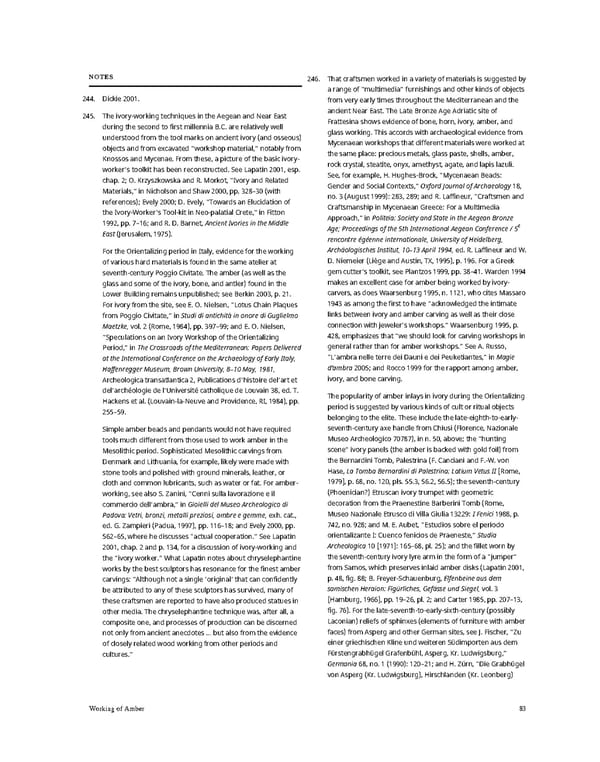NOTES 246. That craftsmen worked in a variety of materials is suggested by a range of “multimedia” furnishings and other kinds of objects 244. Dickie 2001. from very early times throughout the Mediterranean and the 245. The ivory-working techniques in the Aegean and Near East ancient Near East. The Late Bronze Age Adriatic site of during the second to first millennia B.C. are relatively well Frattesina shows evidence of bone, horn, ivory, amber, and understood from the tool marks on ancient ivory (and osseous) glass working. This accords with archaeological evidence from objects and from excavated “workshop material,” notably from Mycenaean workshops that different materials were worked at Knossos and Mycenae. From these, a picture of the basic ivory- the same place: precious metals, glass paste, shells, amber, worker’s toolkit has been reconstructed. See Lapatin 2001, esp. rock crystal, steatite, onyx, amethyst, agate, and lapis lazuli. chap. 2; O. Krzyszkowska and R. Morkot, “Ivory and Related See, for example, H. Hughes-Brock, “Mycenaean Beads: Materials,” in Nicholson and Shaw 2000, pp. 328–30 (with Gender and Social Contexts,” Oxford Journal of Archaeology 18, references); Evely 2000; D. Evely, “Towards an Elucidation of no. 3 (August 1999): 283, 289; and R. Laffineur, “Craftsmen and the Ivory-Worker’s Tool-kit in Neo-palatial Crete,” in Fitton Craftsmanship in Mycenaean Greece: For a Multimedia 1992, pp. 7–16; and R. D. Barnet, Ancient Ivories in the Middle Approach,” in Politeia: Society and State in the Aegean Bronze Age; Proceedings of the 5th International Aegean Conference / 5e East (Jerusalem, 1975). rencontre égéenne internationale, University of Heidelberg, For the Orientalizing period in Italy, evidence for the working Archäologisches Institut, 10–13 April 1994, ed. R. Laffineur and W. of various hard materials is found in the same atelier at D. Niemeier (Liège and Austin, TX, 1995), p. 196. For a Greek seventh-century Poggio Civitate. The amber (as well as the gem cutter’s toolkit, see Plantzos 1999, pp. 38–41. Warden 1994 glass and some of the ivory, bone, and antler) found in the makes an excellent case for amber being worked by ivory- Lower Building remains unpublished; see Berkin 2003, p. 21. carvers, as does Waarsenburg 1995, n. 1121, who cites Massaro For ivory from the site, see E. O. Nielsen, “Lotus Chain Plaques 1943as among the first to have “acknowledged the intimate from Poggio Civitate,” in Studi di antichità in onore di Guglielmo links between ivory and amber carving as well as their close Maetzke, vol. 2 (Rome, 1984), pp. 397–99; and E. O. Nielsen, connection with jeweler’s workshops.” Waarsenburg 1995, p. “Speculations on an Ivory Workshop of the Orientalizing 428, emphasizes that “we should look for carving workshops in Period,” in The Crossroads of the Mediterranean: Papers Delivered general rather than for amber workshops.” See A. Russo, at the International Conference on the Archaeology of Early Italy, “L’ambra nelle terre dei Dauni e dei Peuketiantes,” in Magie Haffenregger Museum, Brown University, 8–10 May, 1981, d’ambra2005; andRocco 1999for the rapport among amber, Archeologica transatlantica 2, Publications d’histoire del’art et ivory, and bone carving. del’archéologie de l’Université catholique de Louvain 38, ed. T. The popularity of amber inlays in ivory during the Orientalizing Hackens et al. (Louvain-la-Neuve and Providence, RI, 1984), pp. period is suggested by various kinds of cult or ritual objects 255–59. belonging to the elite. These include the late-eighth-to-early- Simple amber beads and pendants would not have required seventh-century axe handle from Chiusi (Florence, Nazionale tools much different from those used to work amber in the Museo Archeologico 70787), in n. 50, above; the “hunting Mesolithic period. Sophisticated Mesolithic carvings from scene” ivory panels (the amber is backed with gold foil) from Denmark and Lithuania, for example, likely were made with the Bernardini Tomb, Palestrina (F. Canciani and F.-W. von stone tools and polished with ground minerals, leather, or Hase, La Tomba Bernardini di Palestrina: Latium Vetus II [Rome, cloth and common lubricants, such as water or fat. For amber- 1979], p. 68, no. 120, pls. 55.3, 56.2, 56.5); the seventh-century working, see also S. Zanini, “Cenni sulla lavorazione e il (Phoenician?) Etruscan ivory trumpet with geometric commercio dell’ambra,” in Gioielli del Museo Archeologico di decoration from the Praenestine Barberini Tomb (Rome, Padova: Vetri, bronzi, metalli preziosi, ambre e gemme, exh. cat., Museo Nazionale Etrusco di Villa Giulia 13229: I Fenici 1988, p. ed. G. Zampieri (Padua, 1997), pp. 116–18; and Evely 2000, pp. 742, no. 928; and M. E. Aubet, “Estudios sobre el periodo 562–65, where he discusses “actual cooperation.” See Lapatin orientalizante I: Cuenco fenicios de Praeneste,” Studia 2001, chap. 2 and p. 134, for a discussion of ivory-working and Archeologica 10 [1971]: 165–68, pl. 25); and the fillet worn by the “ivory worker.” What Lapatin notes about chryselephantine the seventh-century ivory lyre arm in the form of a “jumper” works by the best sculptors has resonance for the finest amber from Samos, which preserves inlaid amber disks (Lapatin 2001, carvings: “Although not a single ‘original’ that can confidently p. 48, fig. 88; B. Freyer-Schauenburg, Elfenbeine aus dem be attributed to any of these sculptors has survived, many of samischen Heraion: Figürliches, Gefässe und Siegel, vol. 3 these craftsmen are reported to have also produced statues in [Hamburg, 1966], pp. 19–26, pl. 2; and Carter 1985, pp. 207–13, other media. The chryselephantine technique was, after all, a fig. 76). For the late-seventh-to-early-sixth-century (possibly composite one, and processes of production can be discerned Laconian) reliefs of sphinxes (elements of furniture with amber not only from ancient anecdotes … but also from the evidence faces) from Asperg and other German sites, see J. Fischer, “Zu of closely related wood working from other periods and einer griechischen Kline und weiteren Südimporten aus dem cultures.” Fürstengrabhügel Grafenbühl, Asperg, Kr. Ludwigsburg,” Germania68, no. 1 (1990): 120–21; and H. Zürn, “Die Grabhügel von Asperg (Kr. Ludwigsburg), Hirschlanden (Kr. Leonberg) Working of Amber 83
 Ancient Carved Ambers in the J. Paul Getty Museum Page 92 Page 94
Ancient Carved Ambers in the J. Paul Getty Museum Page 92 Page 94